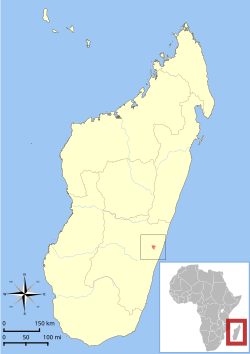| Jolly's mouse lemur | |
|---|---|
| Scientific classification | |
| Kingdom: | Animalia |
| Phylum: | Chordata |
| Class: | Mammalia |
| Order: | Primates |
| Suborder: | Strepsirrhini |
| Family: | Cheirogaleidae |
| Genus: | Microcebus |
| Species: | M. jollyae |
| Binomial name | |
| Microcebus jollyae | |
 | |
| Distribution of M. jollyae [1] | |
Jolly's mouse lemur (Microcebus jollyae) is a species of mouse lemur from Mananjary and Kianjavato in Madagascar. The species is named in honor of primatologist Alison Jolly.[ citation needed ]
Jolly's mouse lemur is uniformly reddish-brown with a small white patch on the snout and a completely gray belly.[ citation needed ]
The finding was announced June 21, 2006 at the Conservation International Global Symposium in Antananarivo, Madagascar, along with the discovery of Mittermeier's mouse lemur Microcebus mittermeieri and Simmons' mouse lemur Microcebus simmonsi as separate species. [4] These new species were also officially announced in a paper in the International Journal of Primatology. [5]
